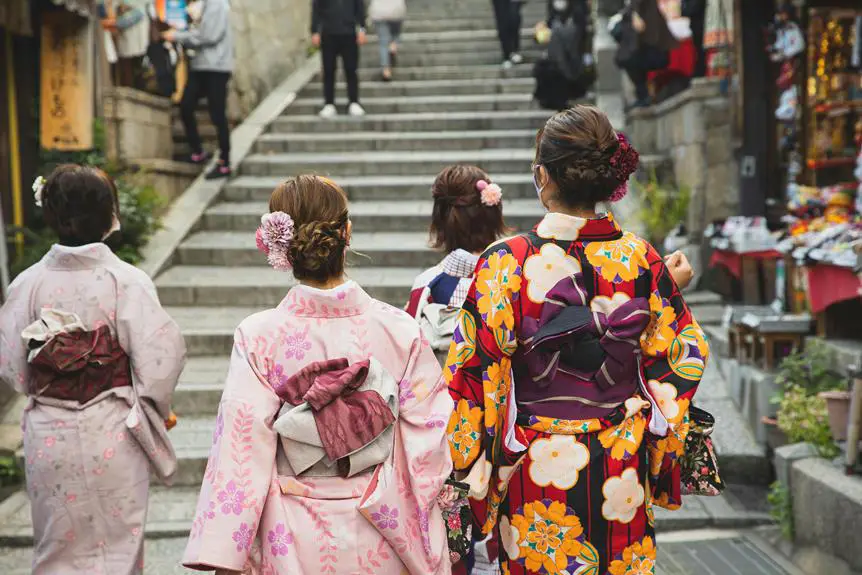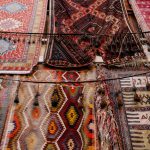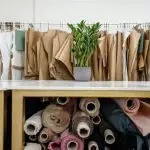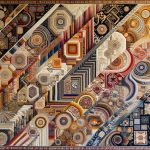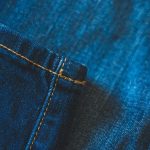When you think about brocade, it's easy to picture the lavish garments worn by the elite in eras like the Renaissance and Baroque. These intricate fabrics, rich with color and texture, weren't just fashion statements—they were symbols of power and prestige. You might wonder how such a fabric, steeped in history, managed to weave its way through various cultures and time periods, influencing not just those who wore it but also the artisans behind its creation. The journey of brocade is far more complex than it seems, revealing layers of artistry and cultural significance waiting to be explored.
Table of Contents
Origins of Brocade
Brocade originated in ancient civilizations, where artisans wove intricate patterns into luxurious textiles for royalty and the elite. You might imagine the skilled hands of these craftsmen meticulously threading gold and silver into fabric, creating stunning pieces that spoke of wealth and status. As you delve into the origins of brocade, you'll discover its rich history tied to trade routes that helped disseminate these beautiful textiles across cultures.
Silk brocade, in particular, emerged from China, where it symbolized prestige and power. You'll notice how the complexity of the designs became a hallmark of skilled artisanship, reflecting not only artistic expression but also cultural significance. Brocade quickly spread to Persia and later to Europe, influencing fashion across continents.
As you explore this fascinating textile, think about how it transformed over time, adapting to the tastes and preferences of different societies. You'll see that brocade wasn't just a fabric; it was a statement, a reflection of identity and status. Understanding its origins gives you a deeper appreciation for its enduring allure in fashion, bridging past and present in a tapestry of elegance.
Brocade in Ancient Civilizations
When you explore brocade in ancient civilizations, you'll uncover its fascinating origins and the intricate weaving techniques that defined it.
You'll also see how these textiles held deep cultural significance, often symbolizing status and wealth.
Understanding this rich history gives you insight into the enduring legacy of brocade in textile arts.
Origins of Brocade Weaving
Throughout history, various ancient civilizations have crafted brocade to showcase their artistry and status. This intricate weaving technique often involved luxurious threads, like silk and gold, to create stunning patterns and textures. The origins of brocade can be traced back to places such as China, Persia, and India, where skilled artisans used their talents to produce textiles that were not only beautiful but also symbolized wealth.
Here's a quick look at some key civilizations and their contributions to brocade weaving:
| Civilization | Key Contributions |
|---|---|
| China | Developed silk brocade techniques, emphasizing intricate designs and vibrant colors. |
| Persia | Introduced elaborate motifs and patterns, often featuring nature and mythology. |
| India | Known for its rich brocade fabrics, including zari work with gold and silver threads. |
| Byzantine | Blended Eastern and Western styles, creating opulent textiles for religious and royal use. |
These civilizations laid the groundwork for brocade weaving, influencing future generations and making brocade a timeless symbol of luxury and craftsmanship. Their unique styles and techniques continue to inspire modern textile artists today.
Cultural Significance in Textiles
Ancient civilizations used brocade not just for clothing, but as a powerful symbol of cultural identity and status. You can see how brocade's intricate patterns and rich textures were a reflection of wealth and power, often reserved for royalty and the elite. This luxurious fabric was more than just a material; it represented the artistry and craftsmanship of the time.
Brocade held significant meaning in different cultures, showcasing:
- Social Hierarchy: The more elaborate the brocade, the higher the status of the wearer.
- Cultural Heritage: Patterns and motifs often depicted historical events, myths, or religious beliefs unique to a civilization.
Renaissance Fashion and Brocade
Embracing opulence and intricate designs, Renaissance fashion showcased brocade as a symbol of wealth and status. As you explore this era, you'll notice how brocade—a rich fabric woven with gold or silver threads—became a staple among the elite. The nobility wore garments adorned with vibrant patterns, displaying their power and influence.
You might find it fascinating that brocade wasn't just about aesthetics; it also reflected the wearer's social standing. The more elaborate the brocade, the greater the prestige. Tailors meticulously crafted these fabrics, often incorporating scenes from mythology or nature, which added layers of meaning to the garments.
When you think of Renaissance attire, envision flowing gowns for women and doublets for men, all embellished with luxurious brocade. These designs weren't merely clothing; they were a statement of identity and ambition.
As you delve deeper, you'll see how brocade transformed with changing trends, adapting to the tastes of each ruling class. This fabric's versatility made it a favorite during the Renaissance, and its legacy continues to influence fashion today.
The Baroque Era's Opulent Styles
In the Baroque Era, fashion took on a lavish flair that reflected its opulent styles.
You'll notice the intricate characteristics of Baroque clothing, shaped by influential designers and artisans who embraced rich brocade fabrics.
Let's explore how these elements came together to create a striking visual impact.
Characteristics of Baroque Fashion
Baroque fashion captivates with its extravagant use of rich fabrics, intricate patterns, and bold colors that reflect the era's desire for grandeur and opulence.
You'll notice that Baroque attire often features lavish embroidery and elaborate trims, showcasing a level of craftsmanship that's hard to match. It's all about making a statement, and the clothing does just that.
Key characteristics of Baroque fashion include:
- Luxurious Materials: Silks, velvets, and brocades dominate, providing a sumptuous feel and stunning visual appeal.
- Dramatic Silhouettes: Clothing is designed with voluminous skirts, padded shoulders, and flowing fabrics that create a striking outline.
When you embrace Baroque fashion, you're not just wearing clothes; you're donning a piece of history that speaks to artistic expression and affluence.
This style invites you to explore the world of texture, color, and form, encouraging you to stand out and celebrate the beauty of opulence.
Influential Designers and Artisans
The opulent styles of the Baroque era were brought to life by visionary designers and artisans who pushed the boundaries of fashion and craftsmanship. You can see their influence in the extravagant garments that dominated the period, reflecting wealth and power.
Designers like Jean-Baptiste Colbert, who served as Louis XIV's minister of finance, understood that fashion was a vital tool for showcasing royal grandeur. He encouraged elaborate styles that featured intricate detailing and luxurious fabrics.
Artisans, particularly weavers and embroiderers, played a crucial role in creating the rich textures and ornate patterns that defined Baroque fashion. They utilized techniques like gold and silver thread embroidery, ensuring that every piece was unique and breathtaking.
Take a moment to appreciate the artistry involved in these creations; each stitch was a testament to the skill and dedication of the craftsmen. The elaborate designs often included motifs inspired by nature and mythology, symbolizing the era's fascination with the dramatic.
Brocade Fabrics in Use
Brocade fabrics adorned the elite during the Baroque era, showcasing their lavish lifestyles through intricate patterns and rich textures.
You'd find these luxurious materials gracing the halls of palaces and the attire of nobility, making a bold statement about wealth and status.
The opulent styles of this period were characterized by the following key features:
- Intricate Gold Threads: These added depth and shine, elevating even simple garments into works of art.
- Vibrant Colors: Deep reds, royal blues, and lush greens captured attention and exuded power.
As you explore fashion today, you can see the influence of Baroque brocade in modern garments and home décor.
Designers often draw inspiration from these rich fabrics, incorporating them into contemporary styles.
Whether it's a chic evening gown or an elegant upholstery fabric, the essence of brocade lives on.
Brocade in Eastern Cultures
Embodying luxury and tradition, brocade has played a pivotal role in the textile heritage of Eastern cultures. You'll find its rich textures and intricate patterns woven into traditional garments and ceremonial attire. Regions like India, China, and Persia have celebrated brocade not just as a fabric, but as an art form that signifies status and cultural identity.
In India, brocade is often handcrafted with gold or silver threads, showcasing elaborate motifs that reflect the region's history and artistry. Chinese brocade, known for its vibrant colors and silk compositions, has been a symbol of wealth since ancient times. Persian brocade, with its unique floral designs, also serves as a testament to the region's rich artistic traditions.
Here's a brief overview of brocade's significance in these cultures:
| Country | Significance of Brocade |
|---|---|
| India | Handcrafted with gold/silver threads |
| China | Symbol of wealth and vibrant colors |
| Persia | Unique floral designs |
| Japan | Used in kimonos and ceremonial wear |
With its deep roots in Eastern cultures, brocade continues to inspire admiration and respect.
Revival of Brocade in Modern Fashion
A resurgence in appreciation for brocade has sparked its integration into contemporary fashion, blending tradition with modern aesthetics. You'll notice brocade making appearances in various collections, showcasing its versatility and charm. Designers are reimagining this luxurious fabric, giving it a new life in today's wardrobes.
You might find brocade in:
- Evening Wear: Elegant gowns and cocktail dresses that exude sophistication and glamour.
- Casual Styles: Trendy jackets and trousers that add a touch of opulence to everyday outfits.
This revival isn't just about nostalgia; it's about embracing the intricate designs and rich history of brocade while adapting them to modern sensibilities. You can effortlessly incorporate brocade pieces into your wardrobe, allowing you to express your unique style.
Whether you choose a bold brocade piece or subtle accents, you'll be part of a trend that celebrates the fabric's timeless allure. As brocade continues to flourish in the fashion landscape, you'll find countless ways to enjoy its elegance and heritage in your daily life.
Brocade's Influence on Contemporary Designers
Influence from brocade has inspired contemporary designers to craft innovative collections that fuse traditional techniques with modern aesthetics. You'll notice that luxury brands are reinterpreting this rich textile in fresh ways, incorporating its ornate patterns and textures into their designs. By doing so, they're paying homage to history while making it relevant for today's fashion landscape.
Here's a look at how brocade is making waves in contemporary design:
| Designer | Collection Inspiration | Key Elements |
|---|---|---|
| Dolce & Gabbana | Sicilian heritage | Bold florals, vibrant colors |
| Etro | Bohemian chic | Intricate paisley brocade |
| Balmain | Rock-inspired elegance | Metallic threads, structured cuts |
| Valentino | Romantic silhouettes | Soft draping, vintage motifs |
These designers are weaving brocade into their narratives, creating pieces that resonate with both nostalgia and modernity. As you explore collections this season, keep an eye out for how brocade transforms garments, elevating them from simple attire to works of art. It's clear that this fabric remains a vital source of inspiration in the fashion world.
Frequently Asked Questions
What Materials Are Commonly Used to Create Brocade Fabric?
When creating brocade fabric, you typically use silk, polyester, or cotton. These materials allow for intricate patterns and textures, giving the fabric its luxurious feel and appearance that's perfect for formal wear and upholstery.
How Do You Care for Brocade Garments?
To care for brocade garments, you should dry clean them to preserve their intricate patterns. Avoid washing in water, and store them away from direct sunlight to prevent fading and damage. Handle gently to maintain quality.
Is Brocade Suitable for Everyday Wear?
Brocade can be suitable for everyday wear if styled wisely. Pair it with casual pieces or accessories to balance its richness. Just remember, its intricacy might require careful handling to maintain its beauty.
What Are the Differences Between Brocade and Damask?
Brocade features raised patterns, often with gold or silver threads, while damask has a flat, reversible design with intricate patterns. You'll find brocade to be more textured, whereas damask offers a smoother, elegant finish.
Can Brocade Be Used in Home Décor?
Absolutely, you can use brocade in home décor! Its rich patterns and textures add elegance to upholstery, cushions, and drapes, creating a luxurious atmosphere that enhances your space's overall aesthetic. You'll love the transformation!
- The History and Evolution of Chamois Fabric - June 22, 2025
- Chamois Fabric on Wikipedia: What You Need to Know - June 22, 2025
- How to Pronounce Chamois Fabric Correctly - June 22, 2025

